5.5 Hooray for Hollywood
As well as Apollo photographs being reproduced in slides and in popular journals, they were also used in popular TV programmes and films almost as soon as they were publicly available, meaning that many people will have seen Apollo photographs without even realising it. Let’s now look at some fine examples of Apollo images in popular culture so that we can prove that you could see Apollo pictures quite easily, and that they weren’t hidden away from the public gaze. I’ll try and present them in some sort of chronological order.
One of the earliest examples comes from the now legendary Star Trek programme. In the next section I’ll show some not so realistic Earth images, but here we have some use of original Apollo material.
The last episode of the second season was broadcast on March 29, 1968 and was called ‘Assignment Earth’. Although it pre-
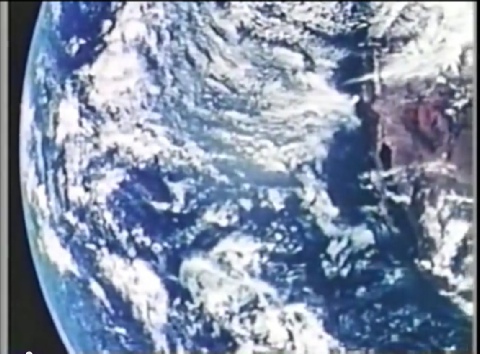
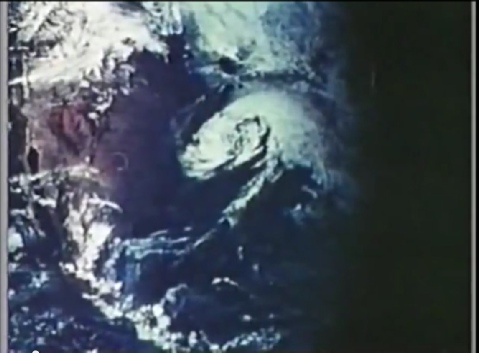

Figure 5.5.13: Apollo 10 Earthrise footage used in ‘Stowaway to the Moon’.
As with the Apollo 16 footage, we’ve already established that these pictures of Earth show exactly what they should show in terms of the Earth’s terminator and the visible weather patterns, and we now have them publicly available decades before youtube would turn every basement internet crusader into an expert on something in which they have no experience or understanding.
Similar proof of Apollo’s veracity can be found in Stowaway’s use of landing footage. I’ve discussed the Apollo 16 landing footage on this page, and shown that there could have been no prior knowledge of the rocks and craters that it shows. Its use in this film (see figure 5.5.14) confirms that it was freely available before the LRO took more detailed images of the Descartes Highlands. Likewise Apollo 11’s view of the lunar surface is discussed here, and the 16mm DAC footage was used in the film (figure 5.5.14) to show the scene immediately after landing. Sadly for the film makers they didn’t seem to notice that the Apollo 11 EASEP equipment was very clearly in shot.
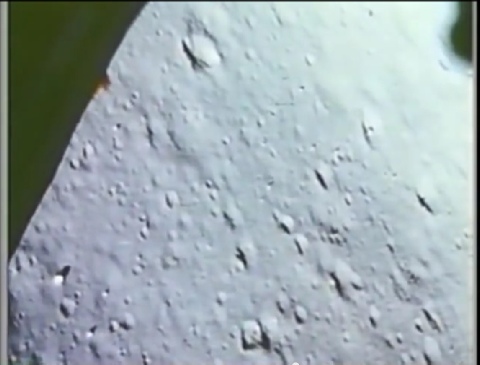
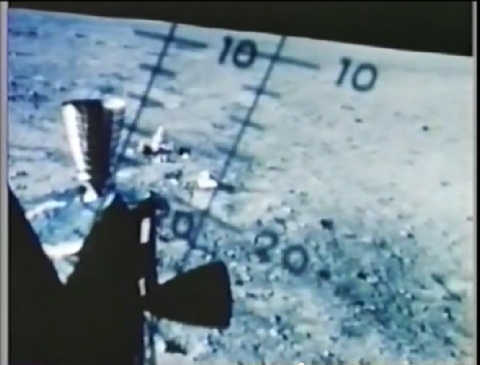
Other unintentional howlers include the sequence supposedly illustrating the docking of the returning LM with the CSM that instead shows the LM inside the SIV-
Perhaps the film’s best use in this context, although it might be slightly unfair to say so given the obvious low budget, is to illustrate just how poor the state of special effects were even 3 years after Apollo ended. In figure 5.5.15 below we have a shot used to show the re-
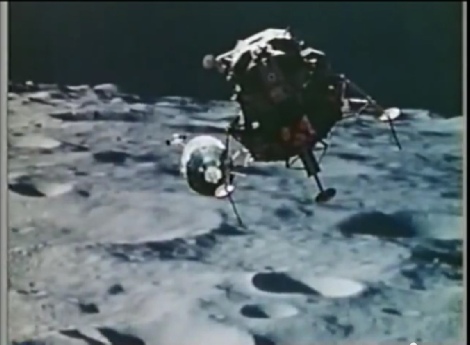

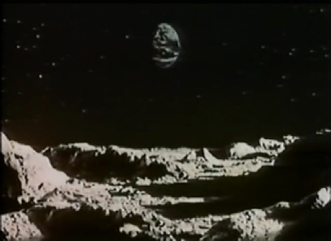
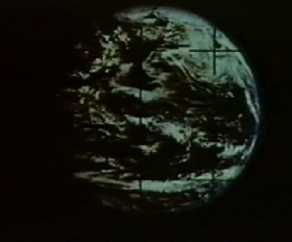
The majestic sweep of Hurricane Bernice is clearly visible just as it is in the original, and nothing has been added or taken away since the photos were taken. The other Apollo image to feature regularly is AS11-
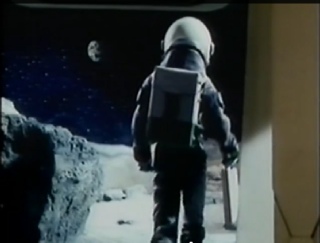
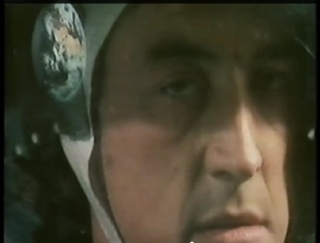
It’s worth pointing out that in the shot where the astronaut is leaving the base, Earth is lit by the sun from the left, but the shadows are falling as if lit from the right. That is how easy it is to make and spot mistakes.
One episode had the base deciding whether to warn Earth of a potential hurricane before it went into blackout thanks to a solar storm. They were therefore required to use an image of Earth with a hurricane on it. Let’s see how they did in figure 5.5.10.

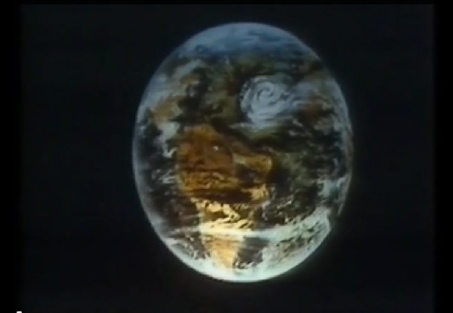
Whatever the merits of the plot and the film’s style, their attempts at reproducing a convincing lunar environment is done well -
Even in 2013, film makers are still using Apollo to show Earth. In Elysium, the hero is given a necklace as a child, and that necklace contains an image of Earth from space. The image they’ve used is from Apollo 8 (see figure 5.5.37).
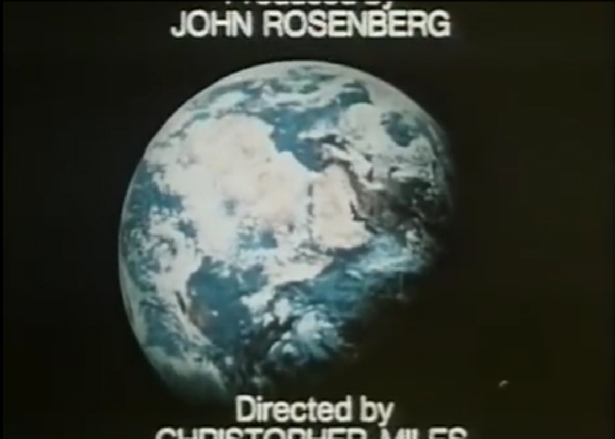
A year later still we have an all-
In the process, they actually make a decent fist of the use of Apollo style control rooms and make good use of Apollo pictures in the process, as shown in figure 5.5.20. By ‘good’, I mean ‘economical’, as they use different parts of the same image to make it look like different scenes quite cleverly.

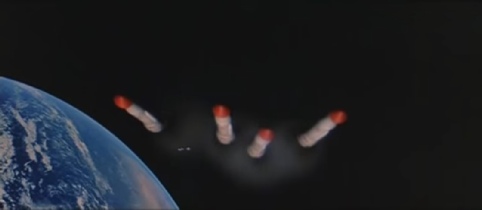
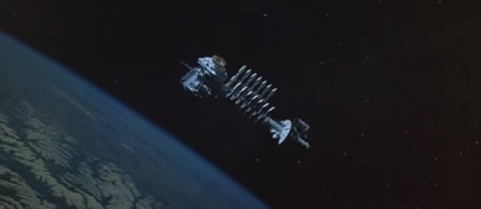
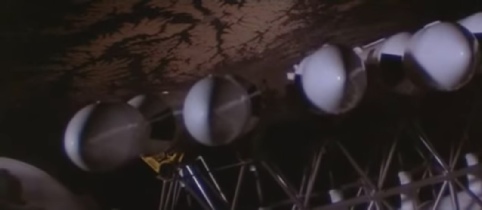

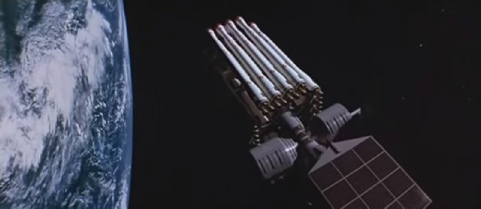
The ‘blue marble’ Apollo 17 image has actually been inverted so that it is a mirror image of that proper one, and also has a cameo role in the another scene where a small corner of it is visible. The Apollo 9 view also makes more than one appearance filmed from different angles. The special effects may have been a little shaky, but the Earth looks great.
Also in 1979 is the utterly abysmal ‘Salvage 1’, a story of a homemade rocket ship heading for the moon to retrieve Apollo hardware for salvage that also somehow got a few seasons as a TV series. The special effects are woeful (the spaceship is very obviously being swung on a rope during the launch sequence), and the script is dreadful. It gets included in the next section of this site thanks to a depiction of a pretend Earth, but here it makes an appearance thanks to its use of (you guessed it) the Blue Marble.
Figure 5.5.21 shows the marble as seen through the broadcast antenna of the now landed spaceship (top left), which is pretty impressive forecasting given that it is also used in their backyard mission control (top right). It gets used again in a ‘coming home’ shot (bottom left). An Apollo 16 shot does get used for variety in one episode.


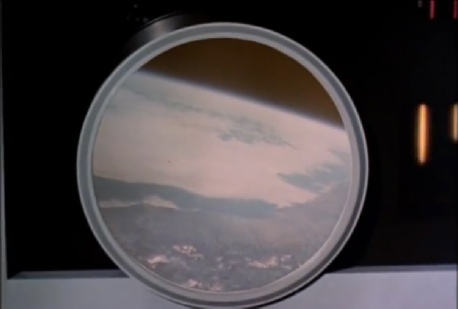
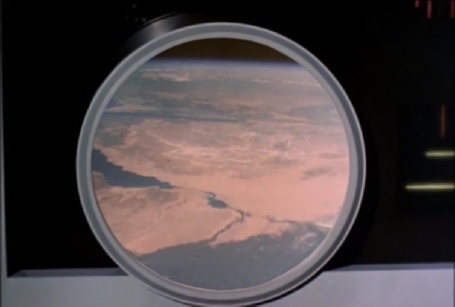
If you bothered to read the section on orbital images you’ll recognise the sequence used from Apollo 4’s separation footage (top right), and the Saturn launch is also Apollo 4 (as can be seen on youtube). The other two images are exceptionally clear views of Earth, as they can’t be taken by Apollo they must be from Gemini missions. A brief trawl through the superb ‘March to the Moon’ website shows that this is exactly where they came from, although the Star Trek versions are horizontally flipped compared with the Gemini originals. The two photographs in question are from Gemini IV (bottom right) and Gemini IX-
Meanwhile in the UK, the British TV series ‘UFO’ was being filmed while Apollo was in progress by the late and legendary Gerry Anderson, and used Apollo images as backdrops. The most obvious one is from Apollo 8 (AS08-
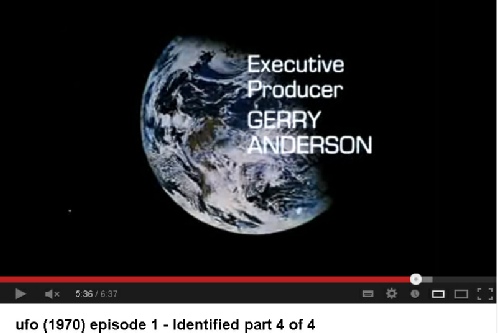
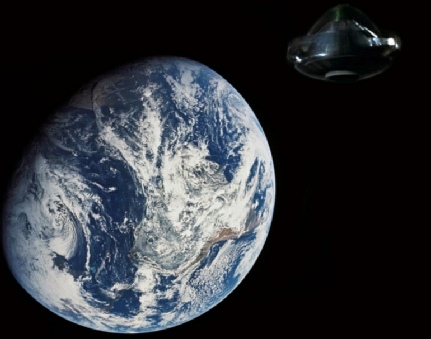
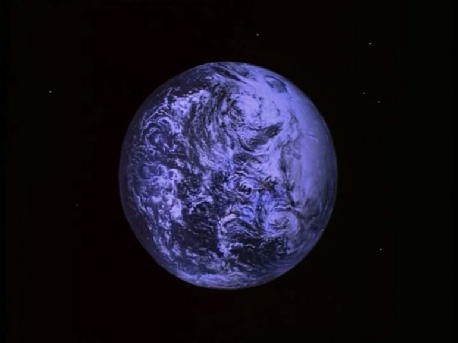
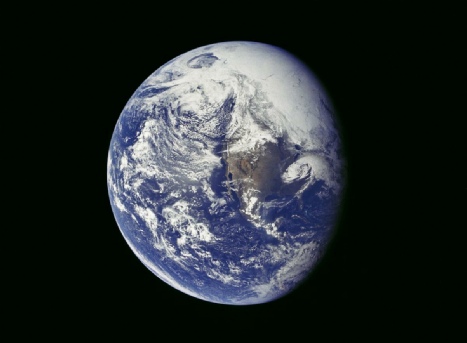
Figure 5.5.6 shows another adapted Apollo image used in the series. In the opening episode of series 1 shows a scene from inside the base, and as the camera pans across the interior a view of Earth can be seen in the window. This image turns out to be an upside down version of AS11-
The sharp eyed reader will have noticed that it’s the same Apollo 16 image used by Space 1999, and they’ve just panned the camera across it.
Perhaps relying on the short attention spans of their young target audience, the same photograph was used towards the end of the film, and used the cunning device of zooming in on the image to illustrate getting closer to home on the way back.
In lunar orbit they use a classic 16mm Earthrise sequence from Apollo 10, this time played in reverse to show that they were going behind the Moon (see figure 5.5.13).
While UFO and Space 1999 have a certain kitsch value about them now, others were pretty corny even at the time. Another gem from the ‘70s also shows us TV’s use of Apollo imagery, although to be honest it seems like the budget only stretched to buying the rights to two of them. Moonbase-
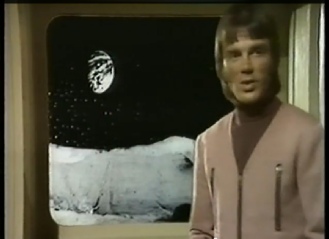
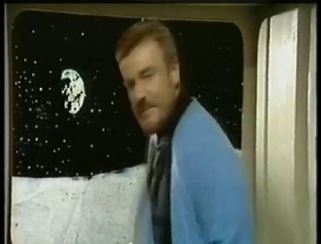
Where do we start? Well, hurricanes in the northern hemisphere spin anti-
A much better use of Apollo in popular culture comes from the incredibly successful ‘Six Million Dollar Man’ series. In an episode entitled ‘Rescue of Athena One’ filmed in 1974, our hero Steve Austin is called upon to rescue Farrah Fawcett-
While it seems a little unsure as to which Saturn rocket it should be showing at launch, and mixes docking footage from lunar module and Skylab sequences the views of the CSM in space are actually quite good, and the dialogue is considerably more accurate than other examples I use here. The first use of Apollo footage comes with a short sequence of Earth, and I’ve spliced together a few screenshots in figure 5.5.11 below.
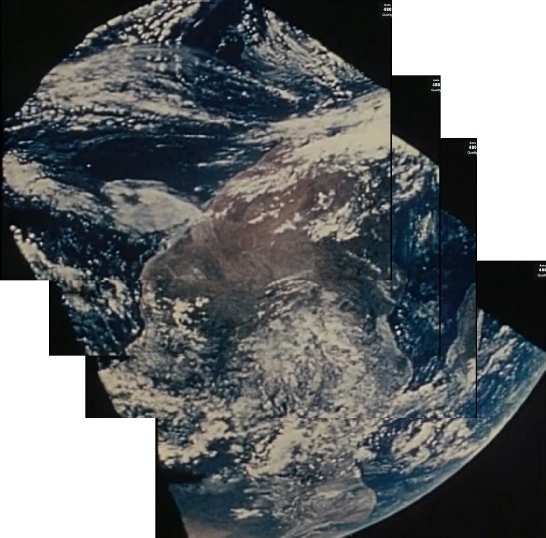
Figure 5.5.11: Composite image formed of screenshots taken from ‘Rescue of Athena 1’
Readers with a good memory will immediately spot that this is the same view of Earth taken by Apollo 17 astronauts and already used in this section, but on this occasion it has not been reversed to compensate for it being shot in a mirror through the CSM window.
There’s some interesting mixing of footage from Apollo 9’s LEO EVA (astronaut has red helmet) and the SIM bay retrieval footage in cislunar space (no red helmet) to show a spacewalk outside Skylab, as well as actual Skylab spacewalk footage. We also have the LM undocking sequence from Apollo 9 mixed in with the animated CSM and Skylab undocking.
The only real failings come with any depiction of the behaviour of people and objects in zero gravity. The only visual device they can use is the exaggerated slow motion movement that they think represents movement in space, rather than the careful but free flowing movement that it actually is. It is my opinion that this dramatic device of using slow motion to simulate space movement has wasted a ridiculous amount of youtube space by people who can’t think independently and seem to think speeding up lunar surface video makes it look normal.
From a decent attempt at replicating space conditions using Apollo footage to a pretty dismal one. The film ‘Stowaway to the Moon’ was sent to me by a contributor (thanks Graham!) and is a 1975 cheese-
There are lots of sequences showing the CSM filmed from the LM, of lunar orbit, and astronauts working on the surface from Apollo 17, but of real interest to us are the sequences where Earth is used.
As part of the post-
Meanwhile in the world of cinema, one of the best sci-
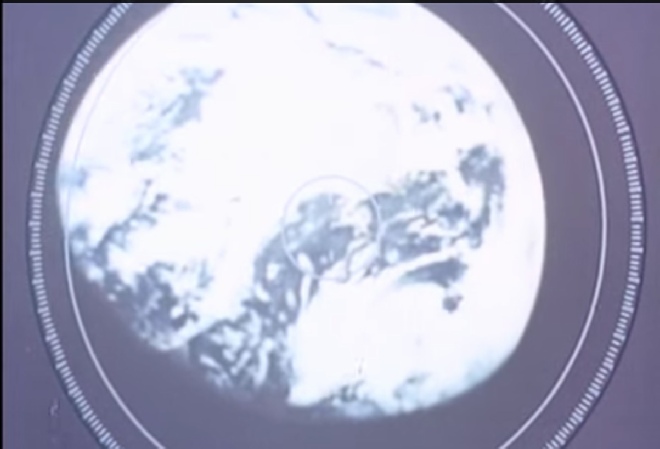
It’s not the best quality reproduction and as a result it isn’t entirely obvious what it is, but if you flip the image horizontally and rotate it, you’ll find it is our old friend AS08-
Returning to TV, Gerry Anderson also produced another immensely popular TV science fiction show in ‘Space 1999’, at that point a year ludicrously far away for most viewers.
This Space 1999 fansite (another Gerry Anderson series filmed in the mid-
A year after this, we have the first mainstream appearance of a sadly departed legend, Robin Williams.
As part of the introduction to the series ‘Mork and Mindy’, which started in 1978, we have the use of Apollo 17’s Blue Marble image (figure 5.5.18).
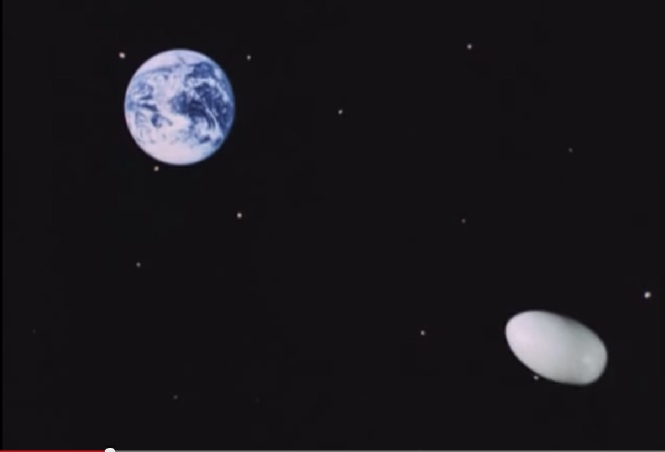
Figure 5.5.18: Apollo 17’s ‘Blue Marble’ used in Mork and Mindy.
Continuing the cold war theme (readers of a certain age will remember the nervy nuclear tensions well) 1985’s ‘Def Con 4’, a cheery tale of nuclear holocaust, makes economical use of an Apollo 9 image (see figure 5.5.27), using all or part of it in several scenes.
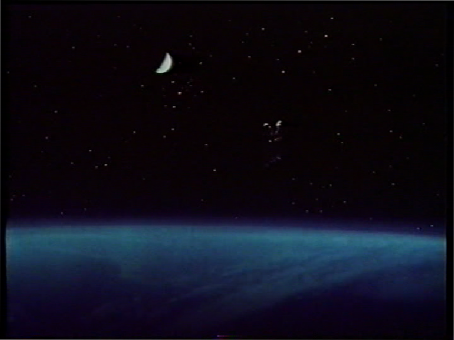
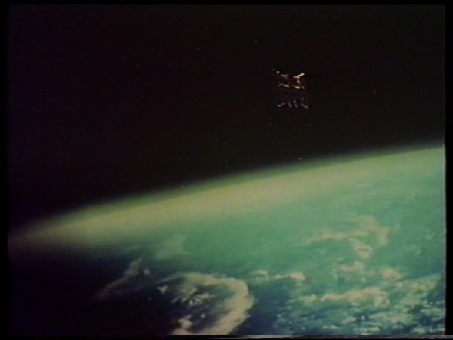
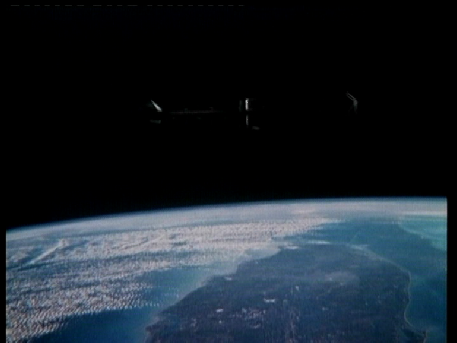
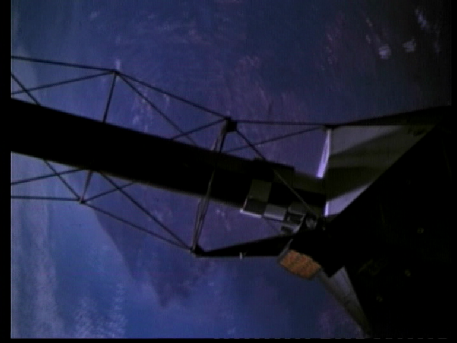
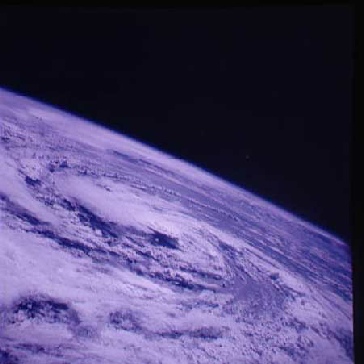
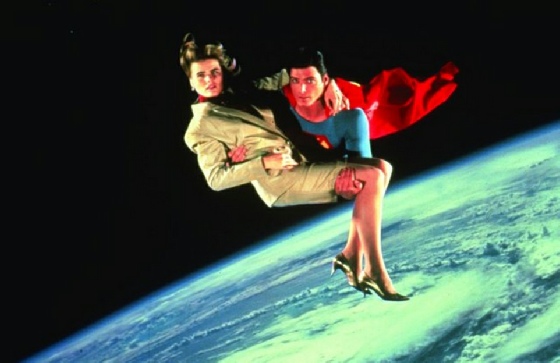
A year later, Superman comes to the rescue in 1987’s ‘Superman IV’, where a horizontally flipped and cropped view of Hurricane Gladys photographed by Apollo 7 appears (figure 5.5.28).

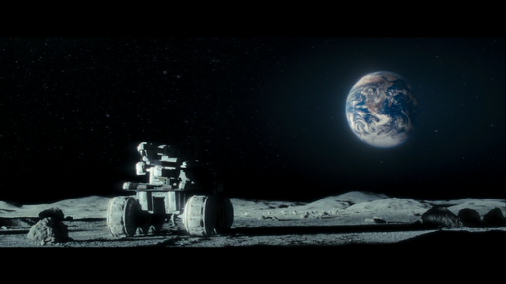
We also have an honourable mention for 2011’s “Apollo 18”, a ‘found footage’ style horror that uses the technique extremely well to incorporate original and slightly modified Apollo images, as well as echoing many of the more famous Apollo moments like saluting the flag and filming astronauts from the LM. The two shots shown in figure 5.5.36 show examples of Apollo images incorporated into the film.
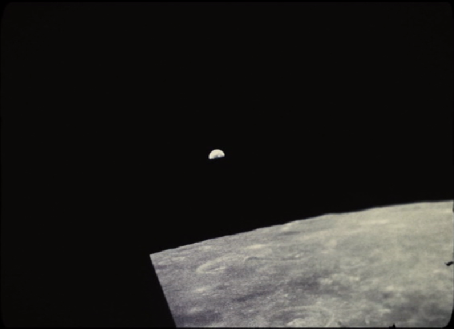
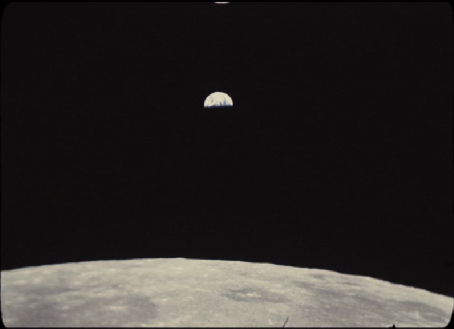
A couple of years later we have 1989’s “Dark Side of the Moon” (no relation to the Pink Floyd classic), a seemingly satanic space film with a very ‘Alien’ like plot. It does feature several views like the one in figure 5.5.29, which bears more than a passing resemblance to the view of Earth taken as part of an Earthrise sequence by Apollo 11.
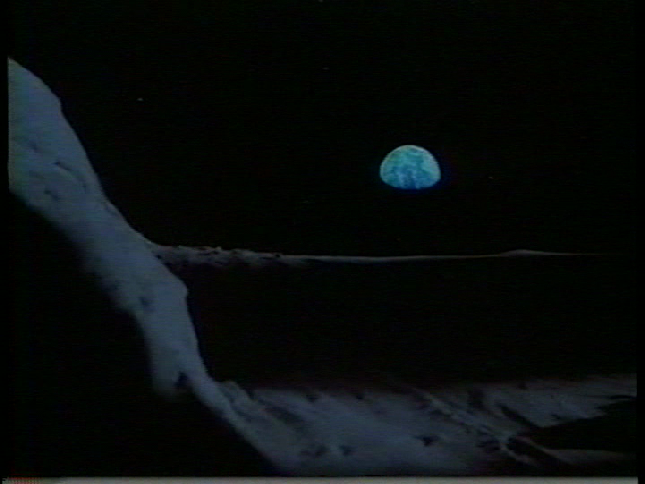


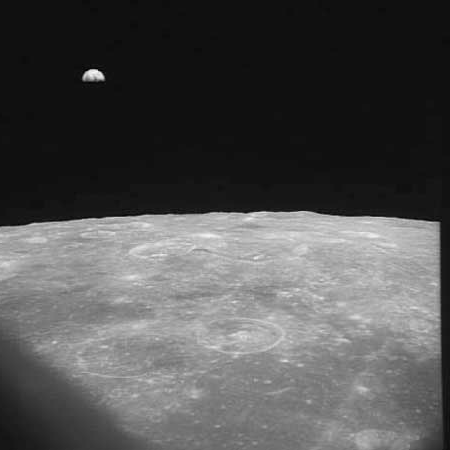
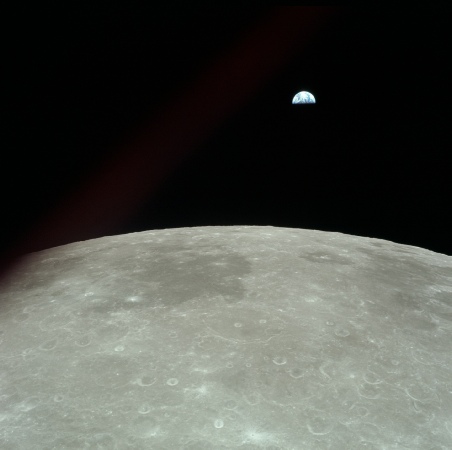
Other visual cues about them being in space are just as badly done. The crew’s movement is illustrated entirely by them moving incredibly slowly, always with one foot on the ground. There is no-
To be fair there are occasional scenes were someone does some floating about and there are no wires visible anywhere, but it is noticeable how short these shots are in comparison to the long uncut sequences seen in Apollo footage and also how forced and unnatural the motion is.
Also from 1975 is another Gerry Anderson production ‘The Day After Tomorrow’, a frankly pretty dreadful tale of deep space exploration that even Brian Blessed can’t rescue. In one shot we have their spaceship of choice against a backdrop of Earth. I’ve turned it the right way up so we can see what it is and shown it in figure 5.5.16.
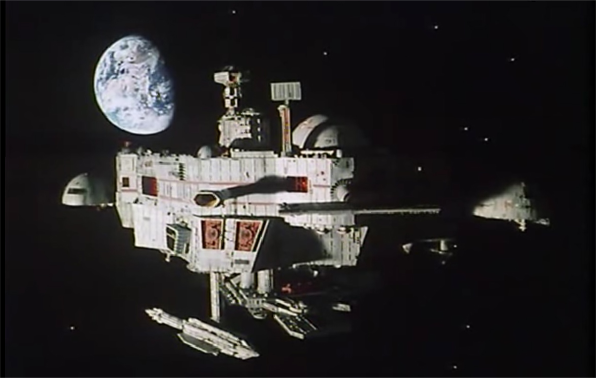
Figure 5.5.16: Screenshot from ‘The Day After Tomorrow (1975)
The image used is one from the outward journey of Apollo showing Africa, AS11-
That image crops up again in what is perhaps one of the most ironic uses of Apollo footage is in the 1977 BBC ‘mockumentary’ “Alternative 3”. It’s ironic because it has often been quoted as being genuine evidence of a hoax, particularly the badly acted and technically incorrect script voiceover for genuine Apollo footage (including the usual Apollo 4 separation and some moonwalk footage). The hoax in this case being that they did actually go to the moon, and also Mars, but the existence of Alien life was covered up on both. The end credits show the familiar Apollo image (figure 5.5.17). Also shown is my own copy of the book that was produced from the TV film. The back cover clearly identifies it as ‘fiction’.
You could argue, and I’m sure some conspiracy theorists will, that this is how easy it is to fool the public. Splice a few stock scenes together, get a half decent script and a few special effects and people will swallow any bullshit they’re fed as long as their brains aren’t made to hurt too much. I for one remember being heartily convinced by ‘Alternative 3’, particularly as I’d just seen ‘Capricorn One’. I was 13, give me a break. I read books and now I know better.
The converse argument is that it really doesn’t take long to spot when mistakes are made, when footage is used repeatedly, and to find from whence footage originated. It’s taken me a very short amount of time between learning about ‘Stowaway...’ and ‘Rescue...’ to find out what footage was used and what continuity errors have been made. Granted it’s easier in the internet age, but there are plenty of experts out there who know how to use a reference book. Not everyone is as dumb as a moon hoax believer, and there are too many people who know what they’re looking at to be fooled for long. Moonbase-
Even modern films with seemingly fine images are soon caught out. As well as the minor Apollo 13 slip-
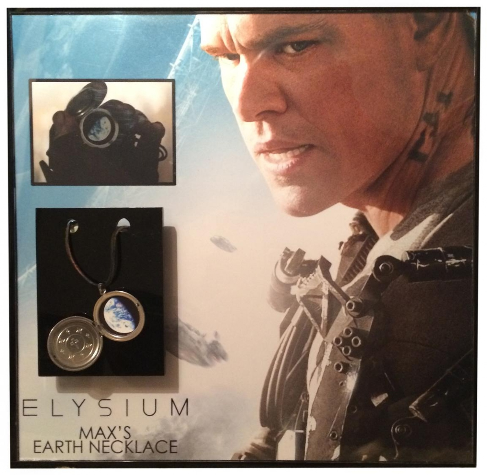

Next we have 1998’s space disaster film “Scorpio One” which once again has our old favourite the Blue Marble on several occasions, and it is still starring nearly 40 years on in 2010’s excellent “Moon” (figure 5.5.35).
Another image that gets used more than once is the famous ‘Blue Marble’ -
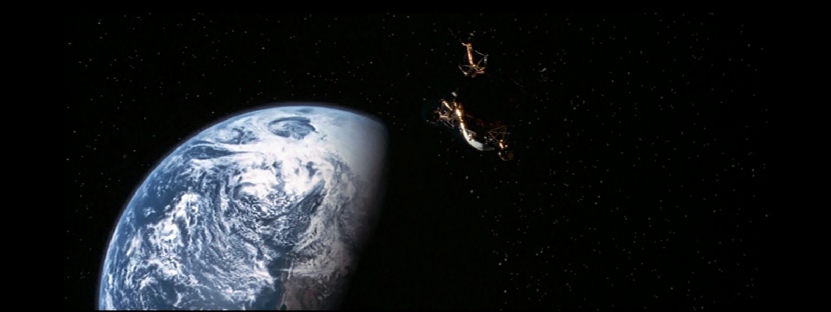
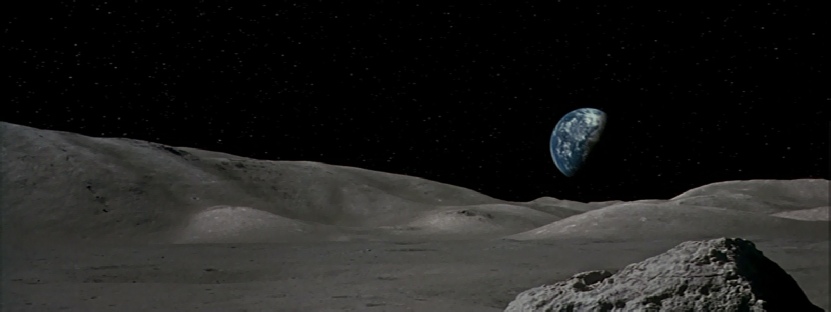
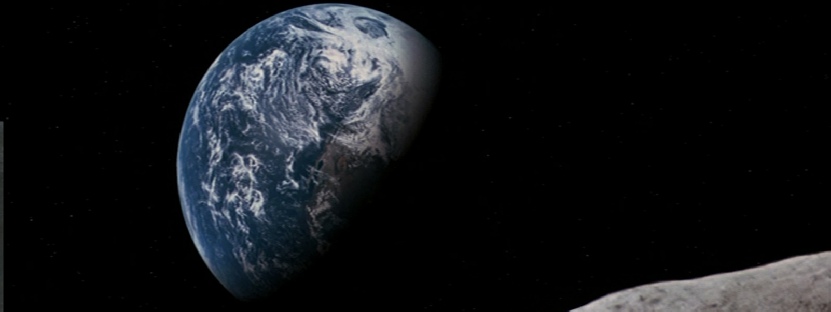
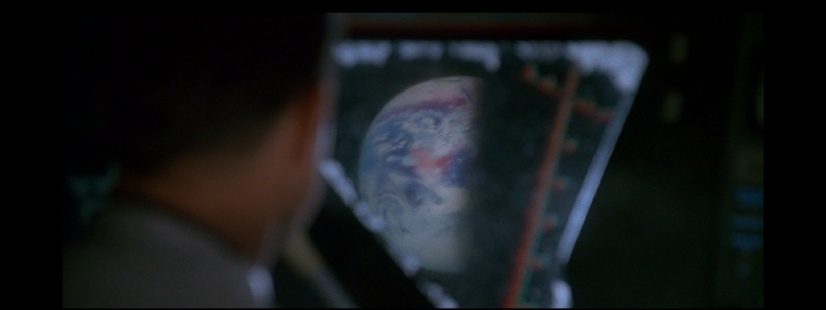
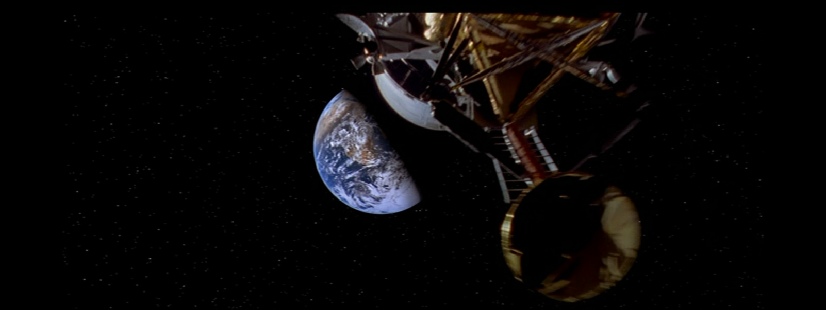
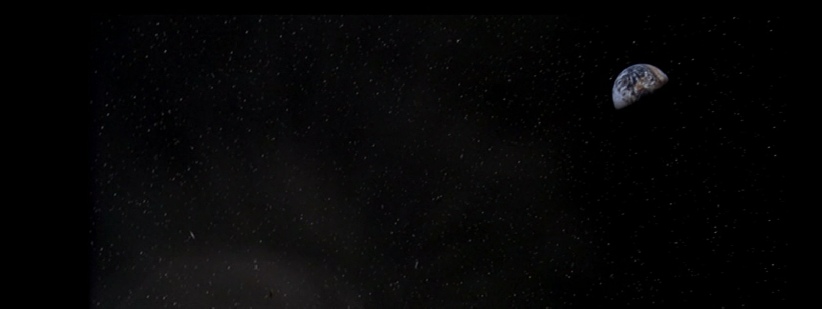
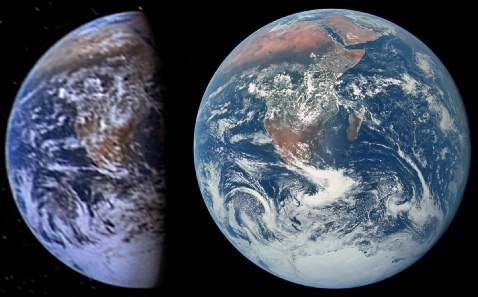
Even a low budget schlock horror movie uses an actual image of Earth when it wants to be accurate, even if they aren’t sure which way up the picture needs to be.
Likewise terrible scifi films and UFO psuedo-
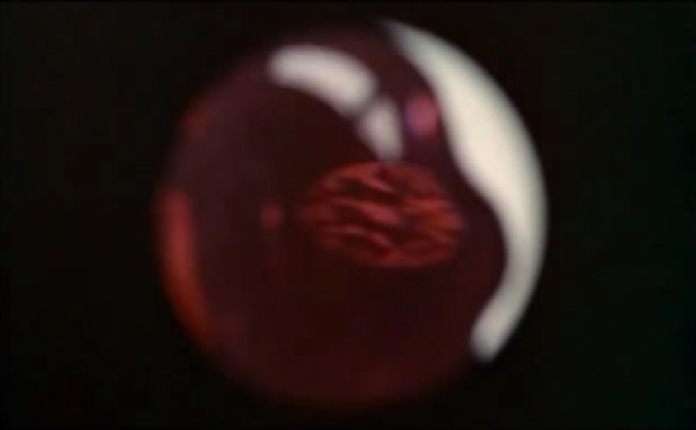
A quick bit of internet searching finds that this image of Earth is, in fact, an upside-
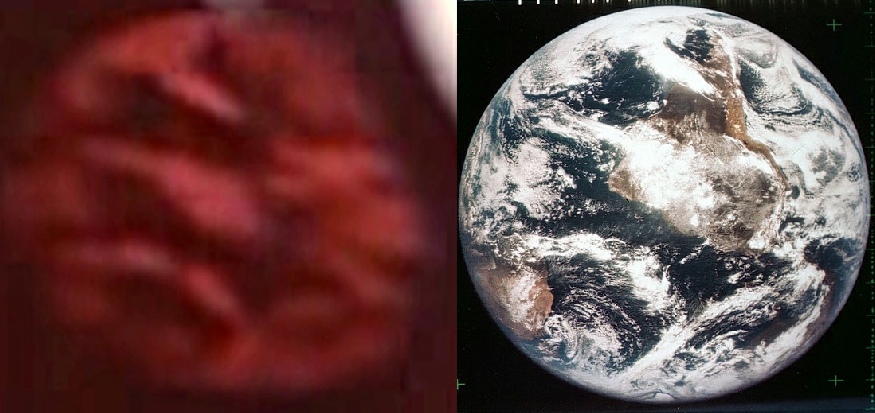
It’s shown three times, and oddly while they show it the wrong way up when the scientists and finally a Rasputin like priest view it, the female viewer who sees it second gets it the right way up (figure 5.5.44).
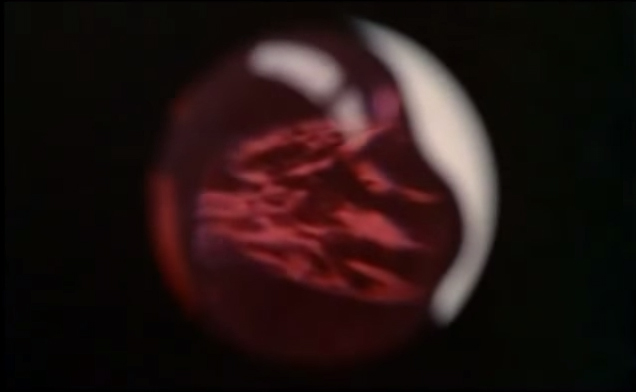
While some film-
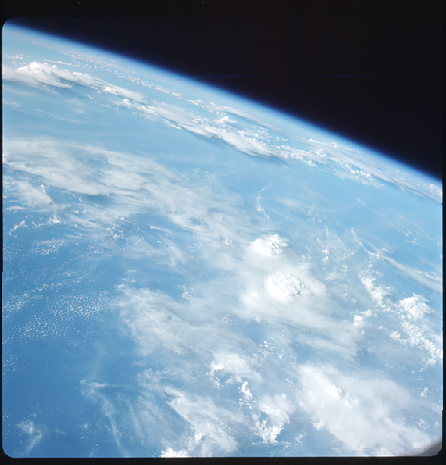
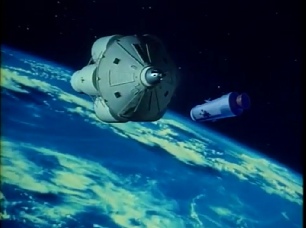
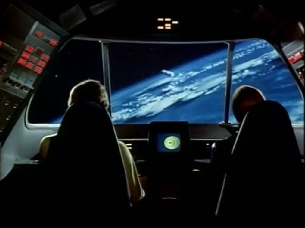
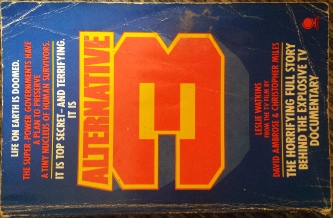
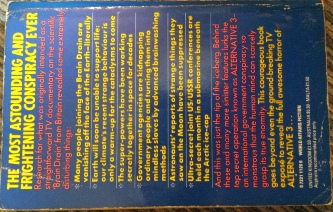
Also from 1978 we have another TV film exploring orbiting space station life and the contributions they could make to an over-
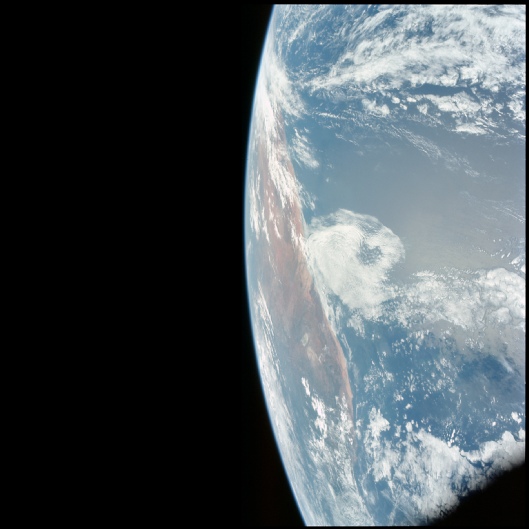
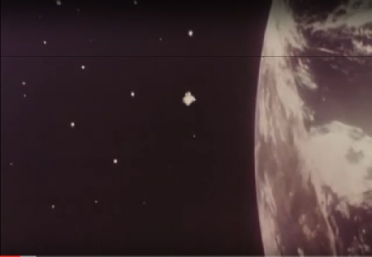
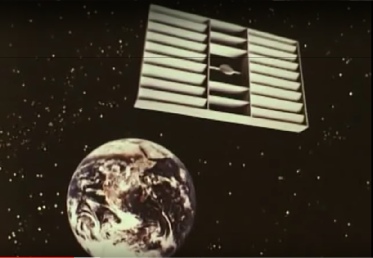
It’s worth pointing out that while the rendering of the lunar surface is good, the lighting appears to be inconsistent, as it seems come from the right in the crater, while Earth is lit correctly from ‘above’.
Also in 1989 we have more low budget sci-

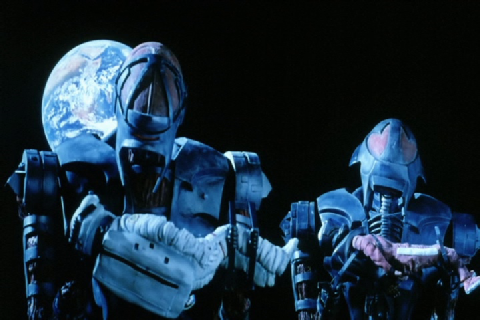
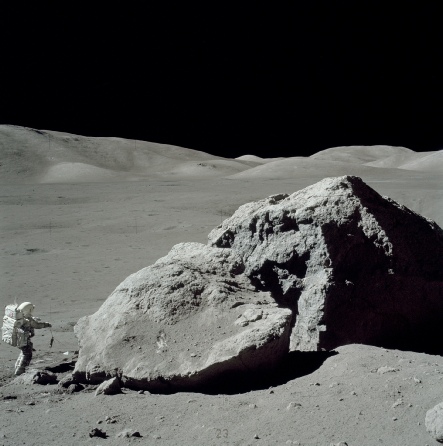
The broader landscape is a clever pastiche of what an be seen in other images of Taurus-
Even into the 1990’s, where film and digital technology has improved by leaps and bounds, Apollo still has a role. Honourable mention here goes to Tom Hanks’ 1995 Apollo 13, which makes good use of images from Apollo 16 and 17. While the recreation of the behaviour of lunar dust and gravity is a little on the shaky side, the use of Apollo 16 image AS16-
By now we’re heading away from the Apollo era and towards the Shuttle era, when views of Earth from LEO become more commonplace and film technology begins to be able to generate more realistic Earths.
Despite this we still see Apollo and even Gemini images being used, even in relatively recent films. The 1984 film ‘The Noah’s Ark Principle’, a cold war story of the threat of destruction from orbit, uses Gemini images for several views of Earth (figure 5.5.25)
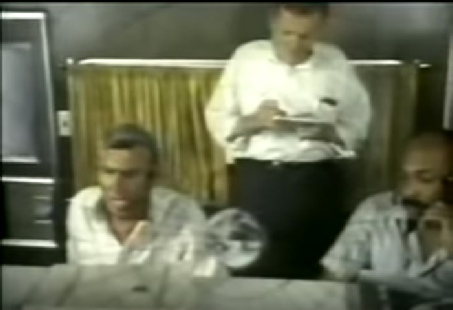
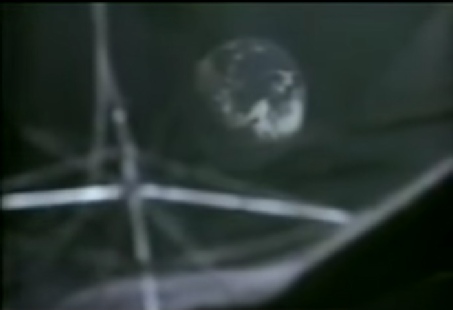
In the same year as Salvage we had the revamp of ‘Buck Rogers’ -
In the screenshots below, for example (figure 5.5.22) we can see our old faithful AS11-
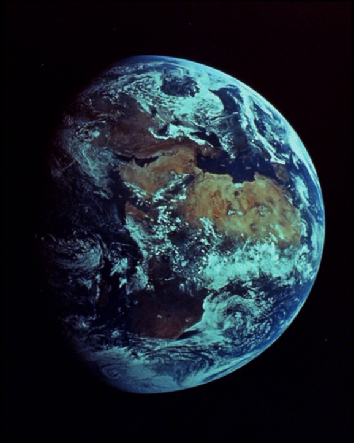
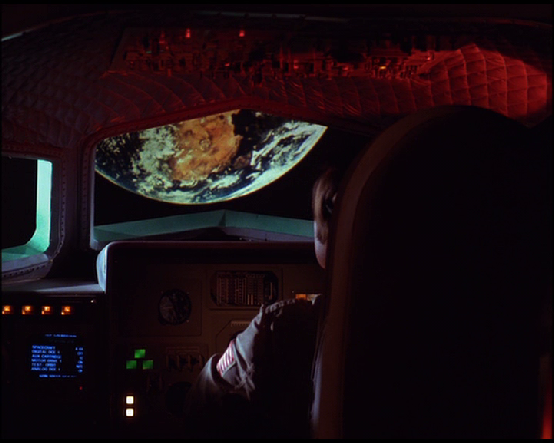
Other images used of Earth were fictional, but the creator of them obviously used Apollo as an inspiration -
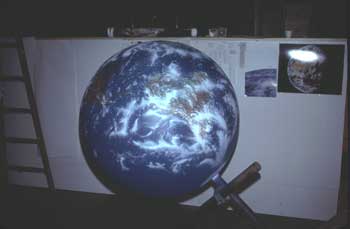
Figure 5.5.23: The work of Janet Kusnick, showing AS11-
Speaking of the Cold War, the US government didn’t mind appropriating Apollo imagery for its own ends, well, after all, they had paid for it. This youtube video showing the proposed ‘Strategic Defence Initiative’ is unated, but the programme was proposed in 1983 by Ronald Reagan. In between the poor quality computer animations we have both the Blue Marble image with pretty missiles painted all over it, as well as an Apollo 11 image (AS11-
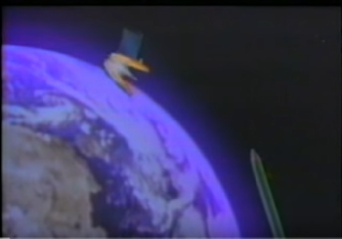
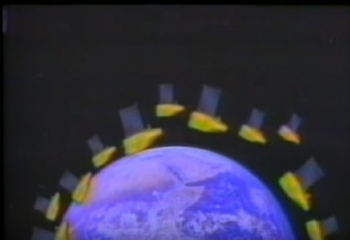

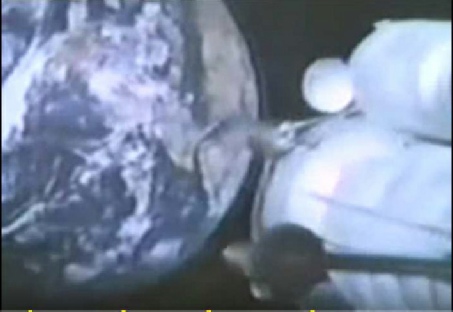
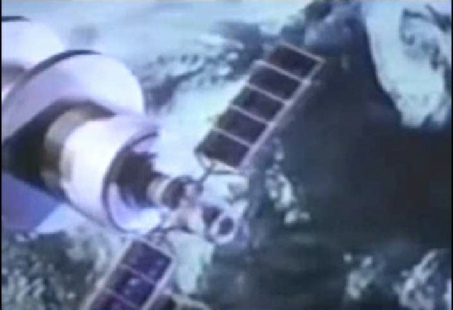
I can only imagine that they thought it just looked nicer.
Honourable mention also goes out to 2011’s ‘Another Earth’. The film is a story of redemption and forgiveness using dreams of escape to an alternative Earth that appears in the evening sky. Some of the Earths hovering in the sky are more modern, such as the 1989 Galileo probe view of Earth as it swung by on its way to Jupiter, and the view of Hurricane Dean from 2007 (figure 5.5.39).

That Apollo 11 image still continues to be used, even when modern CGI could easily generate a convincing one. Here it is in December 2020’s Chanel number 5 advert (figure 5.5.41)
The bulk of the imagery, however, consists of our old friend the blue marble, shown in various stages of fullness with scant regard for the direction of the sun or the gravitational impact on tides and what not. Still, if we can accept the sudden arrival of a duplicate Earth we can accept the various other breachings of the laws of physics. I’m being unfair, it’s a decent film, and it also manages to sneak in a couple of glimpses of Apollo 11 image AS11-
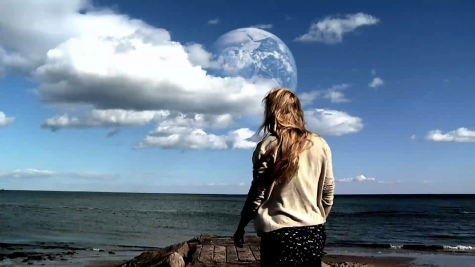
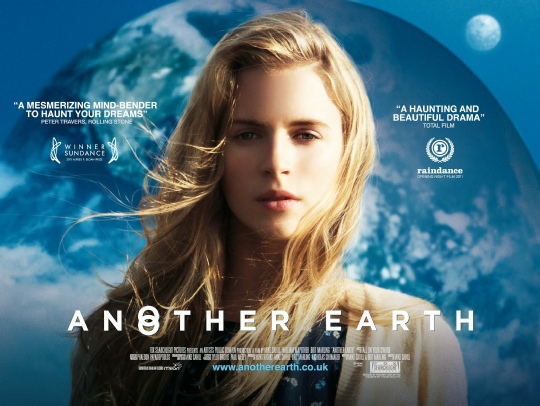
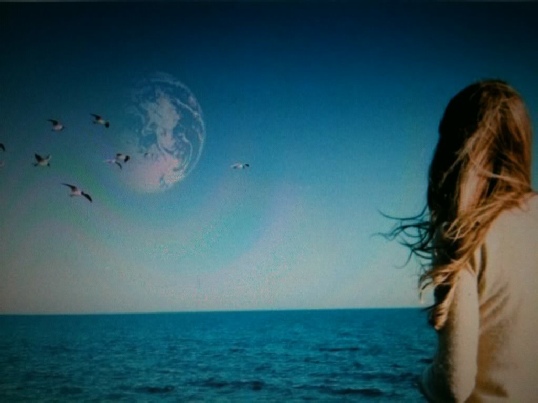
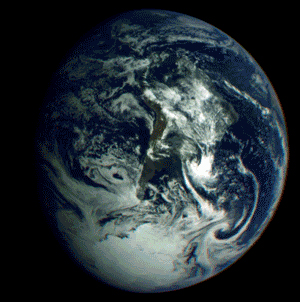
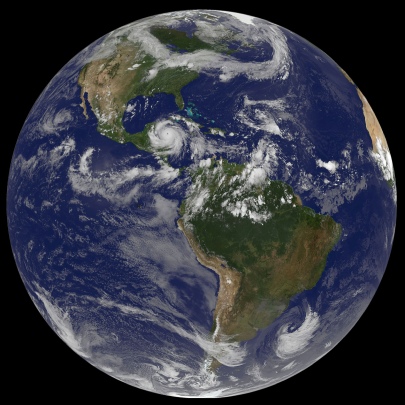
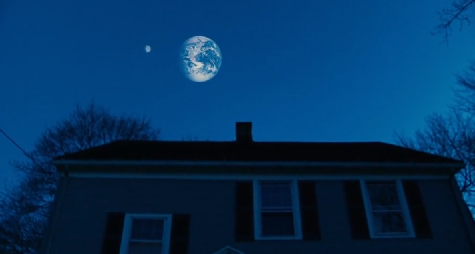
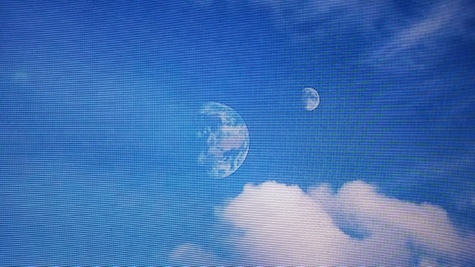
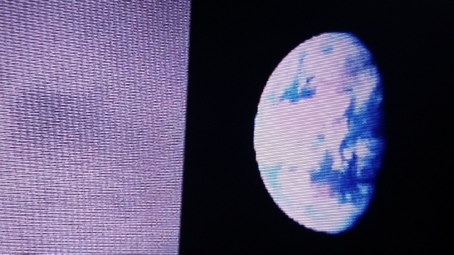
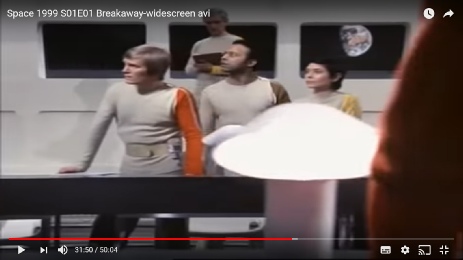
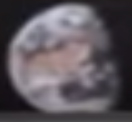
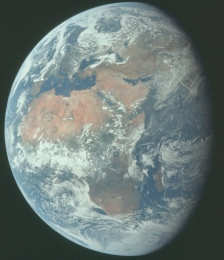
A slightly tweaked version of the same image (or possibly one from the same series of similar ones in that magazine) makes an appearance in the introduction to series 2, as shown in figure 5.5.7.
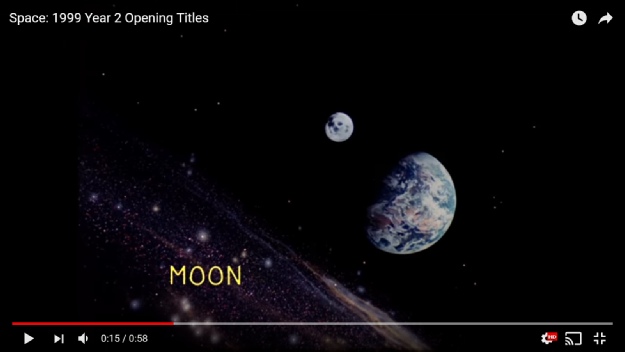
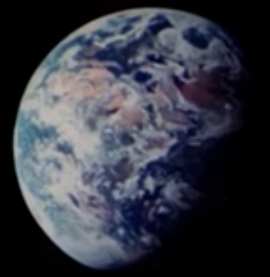
The Blue Marble makes another appearance in the poster for the movie, this time flipped horizontally, as shown in figure 5.5.33 below.
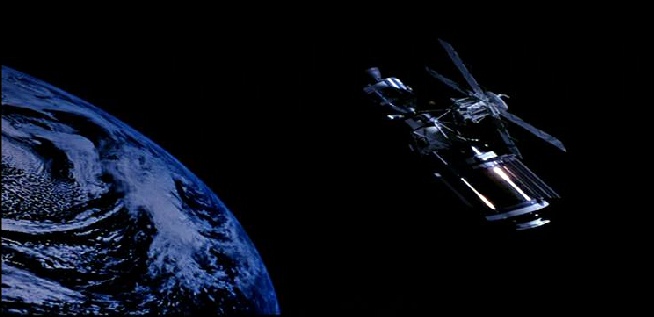
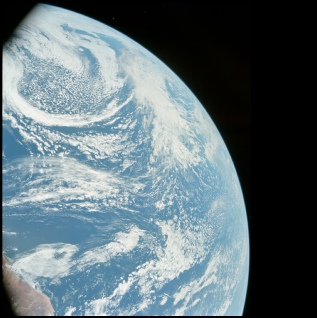
Also from 1995 is cult computer themed movie ‘Hackers’, wherein teen heroes take on the bad guys by hacking into computer systems and sticking it to the man. One clip shows a rather over-

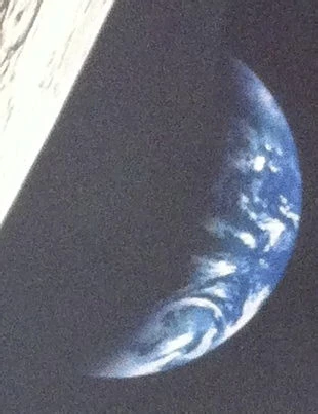
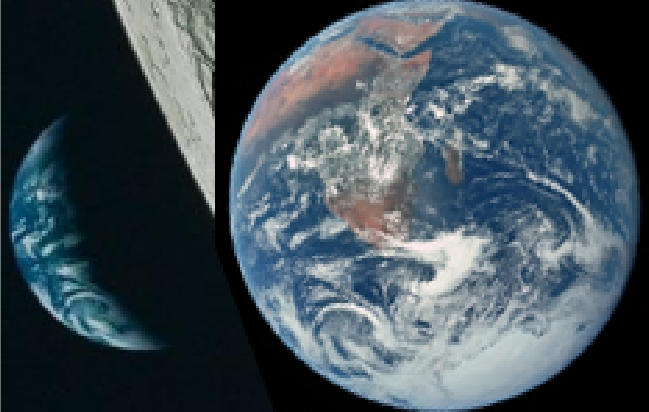
Figure 5.5.33: Apollo 13 movie poster compared with Apollo 17’s Blue Marble
Fine so it’s upside down, but it’s still an Apollo image!
Finally, I must give honourable mention to a film that, although it didn’t use an Apollo image did at least go to some lengths to achieve a level of authenticity that the film didn’t deserve. The film is ‘Horror Express’, a low budget affair where a frozen monster corpse turns out to be an alien being, like they do, whose eyes record memories. When the scientist heroes examine some eyeball fluid (around 48 minutes onwards), it reveals a view of Earth -

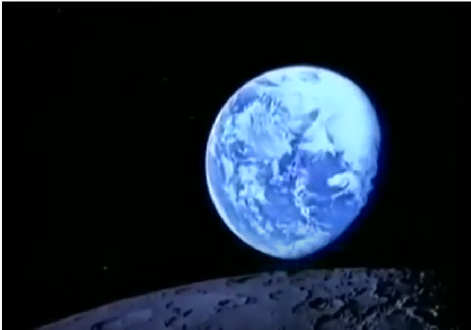
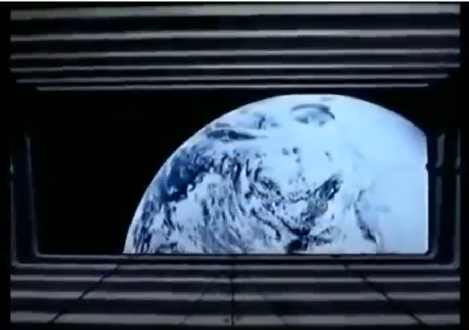
Just as with the popular media of the time, popular fiction’s use of Apollo images (and other space program photographs) pre-
I haven’t proved Apollo landed on the Moon here, but we have shown that the photographs weren’t stashed away in a hiding place -
A late addition to this page stems from claims made by the self-
There contention is that optical printers were used to create the Apollo visual record. Put simply, two different film sources are combined, and then themselves filmed, to create a newly composited original with (they hope) no apparent joins. Masks are used to stop film being exposed and allow the superimposed footage to appear without being partially transparent. Many of the examples cited above will have used a variation on that theme to create them, and it requires painstaking methodical work. Even with that methodical, painstaking approach, the method is only convincing if we allow ourselves to be convinced. Looking back at examples from the 1960s shows how unconvincing they can be.
The Ads claim led to do some studying on the process, and I found this blog. On one of its pages it shows an example of notes made relating to a sequence in Monty Python’s 1979 classic ‘Life of Brian’, where Brian (who is not, as we all know, the messiah, he’s a very naughty boy) unexpectedly finds himself in a battle between two alien spacecraft. Here’s the image they use (figure 5.5.46).
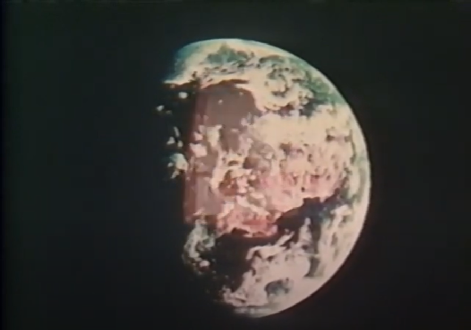
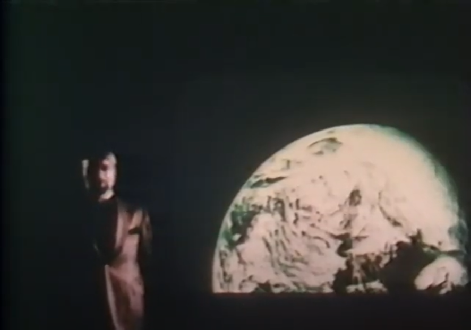
And finally for 1979, we have the opening sequence from the (truly terrible) James Bond film ‘Moonraker’, where the opening sequence for the title song again features the Apollo 16 image used elsewhere (figure 5.5.24).
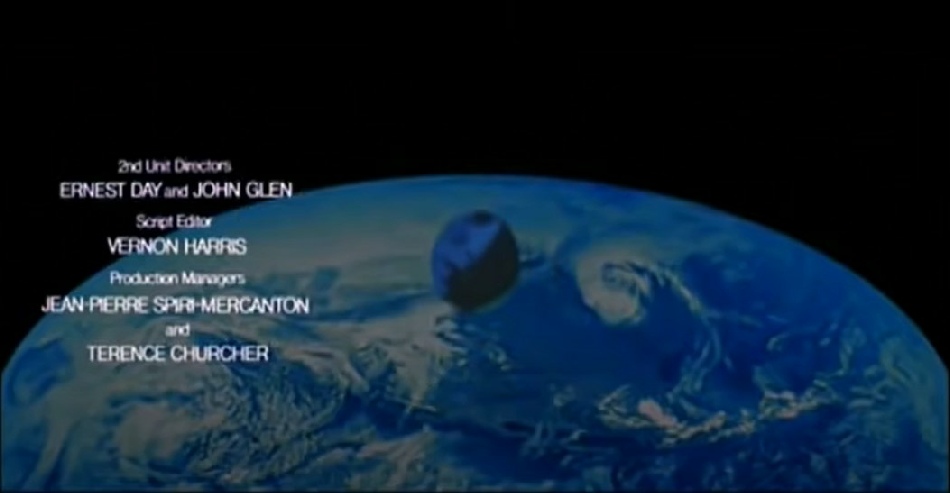
Figure 5.5.24: AS16-
Figure 5.5.1: Screenshots from ‘Star Trek: Assignment Earth’
Figure 5.5.2: Screenshot from an episode of UFO showing AS08-
Figure 5.5.3: S65-
Figure 5.5.4: View of Earth in 1972’s “Silent Running”.
Figure 5.5.5: Fictional planet from Space 1999 (left) compared with AS16-
Figure 5.5.6: Scene from Episode 1 of Space 1999 showing Earth, the rotated Earth, and AS11-
Figure 5.5.7: Scene from the introduction to Space 1999 series 2 and a rotated close-
Figure 5.5.8: AS11-
Figure 5.5.9: AS11-
Figure 5.5.10: Artist renderings of Earth from Moonbase-
Figure 5.5.12: Screenshots from ‘Stowaway to the Moon’.
Figure 5.5.14: Apollo 16mm DAC footage used in ‘Stowaway to the Moon’ a) Apollo 16 (left) and b) Apollo 11 (right)
Figure 5.5.15: Special effect (left) and real (right) footage of the CSM in lunar orbit from the film ‘Stowaway to the Moon’.
Figure 5.5.17: End credits of ‘Alternative 3’, featuring AS11-
Figure 5.5.19: Screenshots from ‘Libra’. On the left is Apollo 17 image AS17-
Figure 5.5.20: Apollo images used in ‘Meteor: AS17-
Figure 5.5.21: Screenshots from ‘Salvage 1’ showing the Blue Marble frm Apollo 17 as well as its use of AS16-
Figure 5.5.22: Screenshots from Buck Rogers in the 25th century.
Figure 5.5.25: Gemini images S66-
Figure 5.5.26: Screenshots from a video outlining the US Government’s SDI program.
Figure 5.5.27: Two uses of AS09-
Figure 5.5.28: Still from Superman IV: The quest for peace compared with AS07-
Figure 5.5.29: Screenshot from ‘Dark Side of the Moon’ compared with AS11-
Figure 5.5.30: ‘Blue Marble’ used on Moontrap, AS17-
Figure 5.5.31: Screenshots from Apollo 13 showing AS16-
Figure 5.5.32: Apollo 17’s Blue Marble appearing in edited form as Apollo rounds the moon (top) unedited through the LM window (centre top) and edited again during the course correction burn (centre bottom) and the actual compared with edited version (bottom).
Figure 5.5.34: Screenshot from ‘Hackers’, compared with AS17-
Figure 5.5.35: Apollo 17’s Blue Marble in ‘Scorpio One’ (left) and “Moon” (right).
Figure 5.5.36: AS10-
Figure 5.5.37: Promotional image showing a still from Elysium with the Earth image in the necklace, and a close up of AS08-
Figure 5.5.38: Apollo 8 Earthrise image featured in ‘Independence Day: Resurgence’
Figure 5.5.39: Screenshots from ‘Another Earth’ showing a Galileo image of Earth (top right and left) and a GOES West satellite image form 2007 (Bottom left and right).
Figure 5.5.40: Screenshots from ‘Another Earth’ showing images from Apollo 17 and Apollo 11
Figure 5.5.41: Apollo 11 image used in Chanel number 5 advert
Figure 5.5.42: Screenshot from ‘Horror Express’ showing a captured memory floating in bodily fluid under a microscope.
Figure 5.5.43: Close up of screenshot in 5.5.34 compared with this ATS-
Figure 5.5.44: ATS-
Figure 5.5.45: Screenshots from “Strange New World” (top left and right) and “Mysteries from Beyond Earth” (bottom left and right).
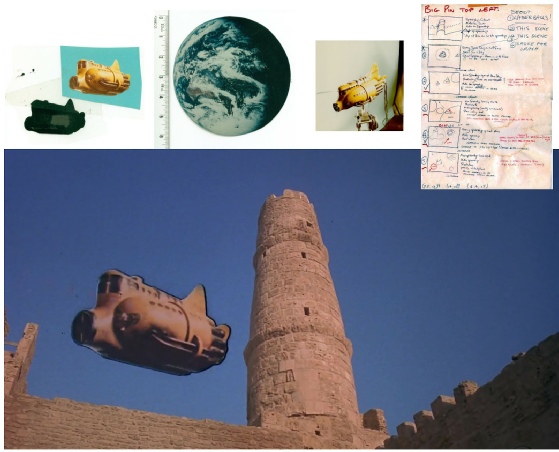
Figure 5.5.46: Notes relating to a scene in ‘Life of Brian’
The Earth image there was taken during Apollo 17, and can be seen in figure 5.5.47.
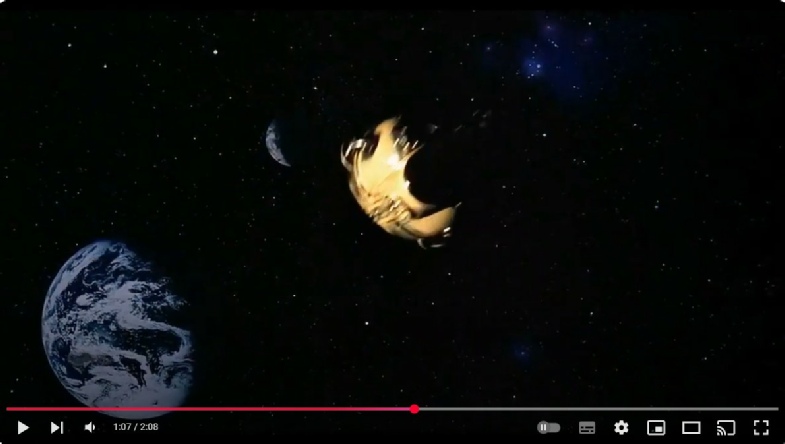
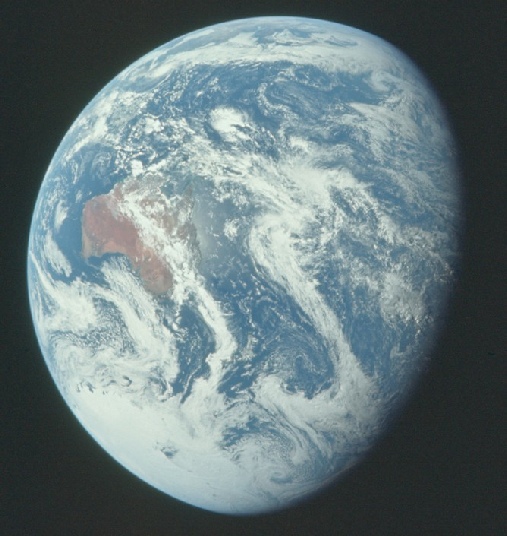
Figure 5.5.47: AS17-
This photo is examined here.
We also have a shot of a crescent Earth, and that turns out to be one of the images taken during Apollo 4 (see figure 5.5.48)
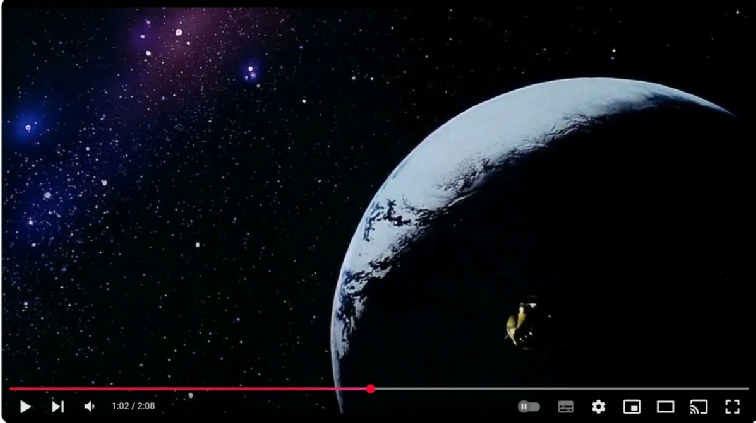
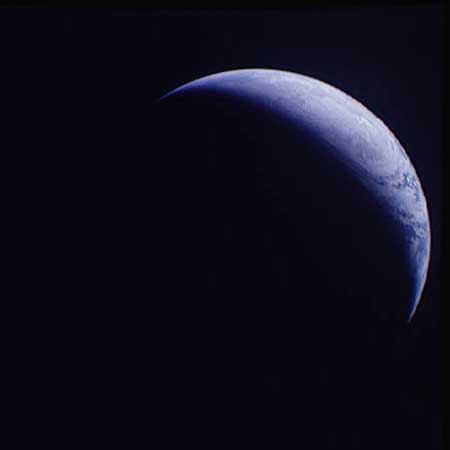
Figure 5.5.48: AS04-
Hopefully it’s obvious that it’s been mirrored in the film.
The remaining view of Earth turns out to be one taken by Apollo 12, shortly after TLI, see figure 5.5.49.
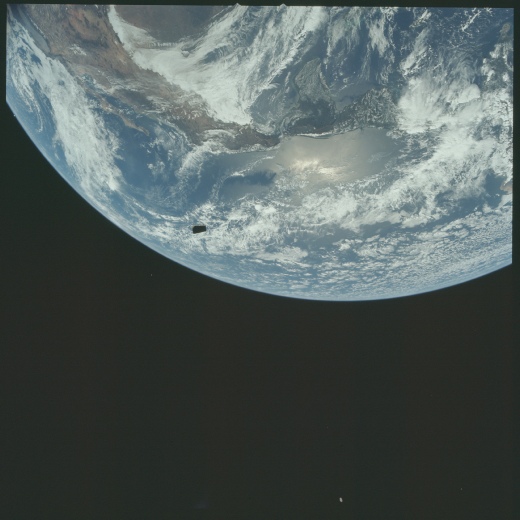
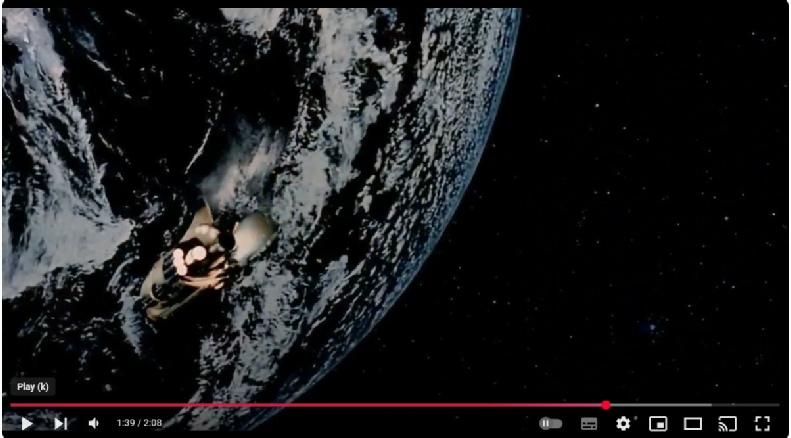
Figure 5.5.49: AS12-
Sharp eyed readers will notice that the SLA panel in the original image has been edited out of the film. This scene was also broadcast on live TV, and I’ve discussed it here.
Honourable mention also needs to go to the image of Copernicus taken by Apollo 12 (figure 5.5.50)
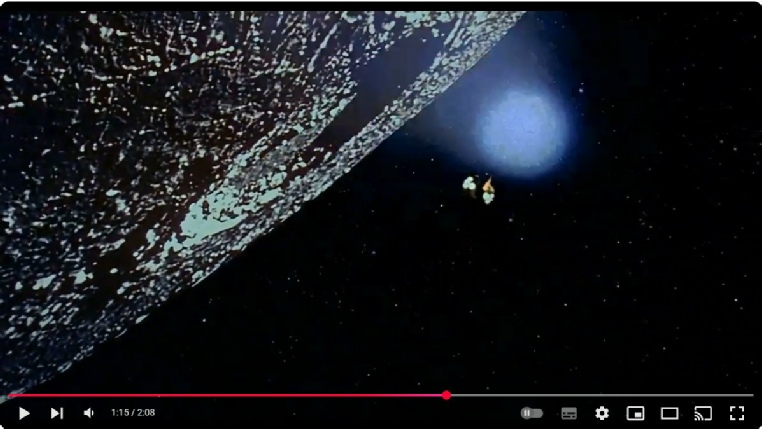
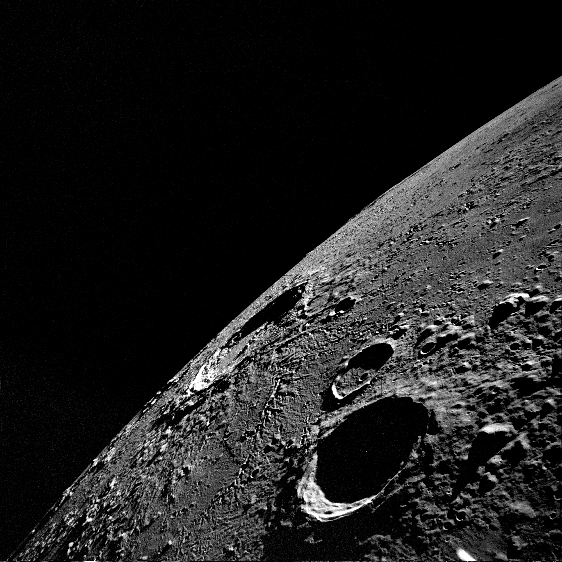
Figure 5.5.50: AS12-
As with the Apollo 4 photograph, this one has been mirrored and then rotated. Finally, we have a glimpse of the moon as a whole, this time from Apollo 8 (figure 5.5.51.
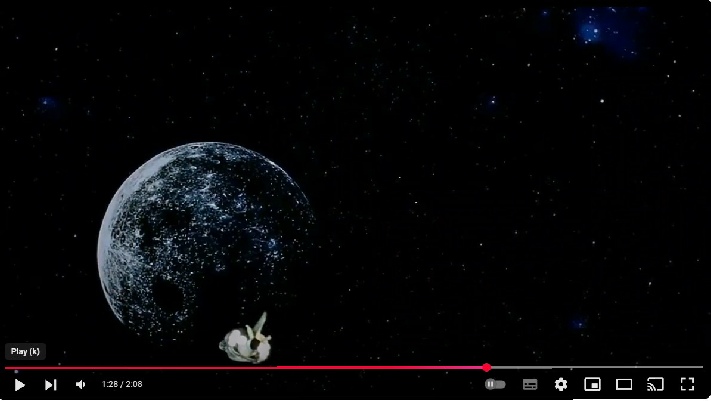
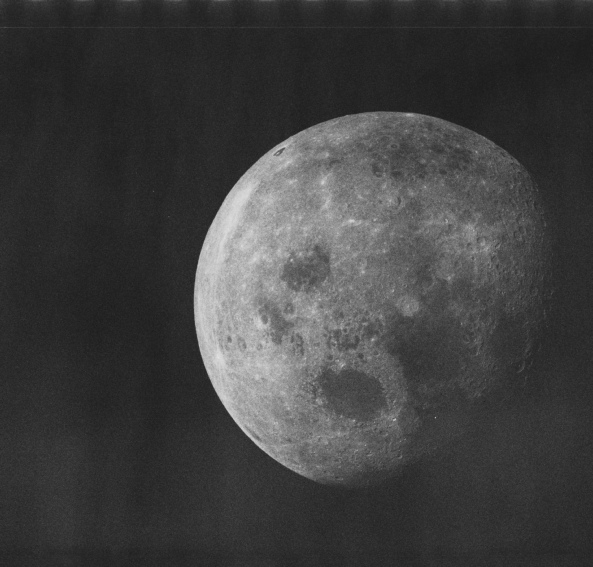
Figure 5.5.51: AS08-
Ironically, the effects in Life of Brian weren’t done using optical printers, but good old fashioned models in front of a static background.
As with all of the claims made by people like the Ads alleging some technique or other used as the method for generating the Apollo photographic and film record, the claims make the process more complex than is feasible. Which precise process was used? How were images obtained to be used in this process, given that they could only have been taken when claimed, and where claimed. How, more than anything, did they achieve the fine level of detail required without getting any errors in the image (there aren’t any, whatever the hoax proponents claim. This excellent history of the technique has this observation from the early days of the process:
“The components must be reassembled with a mathematical precision so fine that the new combinations shall not reveal the joining lines between the welded parts even when magnified hundreds of diameters on the screen.”
Show us the joins ADs, where are they?
Then there are the other issues they need to solve. The Apollo 12 image of Earth was taken at the same time as a live TV broadcast showing an identifiable and verifiable weather feature. The Apollo 8 lunar image above shows a view not visible from Earth. Who was operating this alleged optical printing set up? Where? When? And finally, just because you can demonstrate that a process could have been done (and I’m going to argue that the realism evident in the Apollo record was not achievable at the time using special effects and camera trickery, this does not mean it was. Prove it. Find the personnel, the equipment, the locations, the chain of events that gets these fake photographs into the public area.
Put up or shut up.